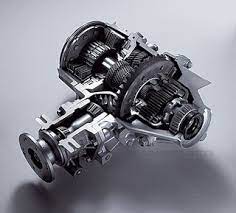
How does the electronic differential lock work?
Content
Electronic Differential Lock is a system that simulates the differential lock using the vehicle's standard braking system. It prevents the drive wheels from slipping when the car starts moving, accelerates on slippery road surfaces or turns. Note that electronic blocking is available on many modern machines. Next, let's look at how an electronic differential works, as well as its application, design, pros and cons.
Principle of operation
A system that simulates a differential lock works in a cyclical manner. There are three stages in the cycle of its work:
- stage of pressure increase;
- pressure retention stage;
- pressure release stage.
At the first stage (when the drive wheel starts to slip), the control unit receives signals from the wheel speed sensors and, based on them, makes a decision to start work. The changeover valve closes and the high pressure valve in the ABS hydraulic unit opens. The ABS pump pressurizes the slip wheel brake cylinder circuit. As a result of an increase in the brake fluid pressure, the skidding drive wheel is braked.
The second stage starts from the moment when wheel slip stops. The system of imitation of blocking of the interwheel differential fixes the achieved braking force by holding pressure. At this point, the pump stops working.
The third stage: the wheel stops slipping, the pressure is released. The changeover valve opens and the high pressure valve closes.
If necessary, all three stages of the electronic differential cycle are repeated. Note that the system functions when the vehicle speed is between 0 and 80 km / h.
Device and main elements
The electronic differential lock is based on the Antilock Brake System (ABS) and is an integral part of the ESC. Locking simulation differs from the classic ABS system in that it can independently increase the pressure in the vehicle's braking system.
Let's consider the main elements of the system:
- Pump: Needed to generate pressure in the braking system.
- Solenoid valves (changeover and high pressure): included in the brake circuit of each wheel. They control the flow of brake fluid within the circuit assigned to it.
- Control unit: controls the electronic differential using special software.
- Wheel speed sensors (installed on each wheel): needed to inform the control unit about the current values of the angular speeds of rotation of the wheels.
Note that the solenoid valves and the feed pump are part of the ABS hydraulic unit.
System varieties
The anti-slip system is installed in the cars of many car manufacturers. At the same time, systems that perform the same functions on different vehicles may have different names. Let's dwell on the most famous ones - EDS, ETS and XDS.
EDS is an electronic differential lock found on most vehicles (eg Nissan, Renault).
ETS (Electronic Traction System) is a system similar to EDS developed by the German automaker Mercedes-Benz. This type of electronic differential has been in production since 1994. Mercedes has also developed an improved 4-ETS system that can brake all wheels of the car. It is installed, for example, on mid-size premium crossovers (M-class).
XDS is an extended EDS developed by the German auto company Volkswagen. XDS differs from EDS by an additional software module. The XDS uses the principle of lateral locking (braking the drive wheels). This type of electronic differential is designed to increase traction as well as improve handling. The system from the German automaker eliminates the understeer of the car when cornering at high speed (this disadvantage when driving is inherent in front-wheel drive cars) - while handling becomes more accurate.
Benefits of an electronic differential lock
- increased traction when cornering the car;
- start of movement without wheel slip;
- adaptive setting of the degree of blocking;
- fully automatic on / off;
- the car confidently copes with the diagonal hanging of the wheels.
Application
Electronic differential, as a function of traction control, is used in many modern cars. Locking imitation is used by such car manufacturers as: Audi, Mercedes, BMW, Nissan, Volkswagen, Land Rover, Renault, Toyota, Opel, Honda, Volvo, Seat and others. At the same time, EDS is used, for example, in Nissan Pathfinder and Renault Duster cars, ETS - on Mercedes ML320, XDS - on Skoda Octavia and Volkswagen Tiguan cars.
Due to their many advantages, blocking simulation systems have become widespread. The electronic differential has proven to be the most practical solution for the average city car that does not travel off-road. This system, preventing wheel slip when the car starts moving, as well as on slippery road surfaces and when cornering, made life much easier for many car owners.


One comment
FERNANDO H. DE S. COSTA
How to disable the Electronic Rear Differential Lock on the NISSAN PATHFINDER SE V6 1993 3.0 12V GASOLINE